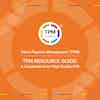Why a TPM Resource Guide for CTE?
We are in an economy that competes on talent. Employers in a variety of industries are facing chronic skill shortages and are eagerly exploring new strategies to work with education partners to address their talent attraction, sourcing, retention, as well as diversity and equity needs.
Learners also must be effective in their pursuit of career awareness and exploration activities and in connecting their education, training, and credentialing to employment. Workers too must find, access, and complete upskilling opportunities to achieve upward economic mobility.
Moreover, state leadership, as well as high schools and colleges, are exploring new strategies for engaging employers in ways that improve their responsiveness to employer needs. Complementary to this objective is enhancing career pathways and programs of study, particularly if simultaneously addressing opportunity gaps for populations with barriers to education, employment, and career advancement.
Strengthening relationships between employers and CTE is more important now than ever before. However, while the need for stronger employer and CTE partnerships is self-evident and growing, there remains major systemic challenges when it comes to engaging employers and sustaining these partnerships at the scale needed for our current economy.
Who is the Resource Guide for?
The intended audience of this resource is CTE system leaders and practitioners as well as their employer partners; though other stakeholders interested in TPM may also benefit from the resources contained herein.
What is Included in the Resource Guide?
This guide provides a set of resources that can be used to explore how TPM can be leveraged as a framework as well as a set of strategies, to build stronger employer and CTE partnerships. Building successful partnerships requires employers and the CTE community to develop a mutual understanding of each other’s worlds and the roles that different professionals and organizations play in making partnerships work. The guide is designed to both introduce newcomers to TPM as well as enhance the existing TPM movement. In addition to this introduction, the guide is composed of three core resources, identified and described below:
Resource 1: CTE Orientation to the Employer Community—This resource is intended for the CTE community as an orientation to better understand the employer community and the professional roles therein.
Resource 2: Employer Orientation to the CTE Community—This resource is intended for the employer community as an orientation to better understand the CTE community, the professional roles therein, and the policy landscape that undergirds CTE in the United States.
Resource 3: Improving Employer Engagement in CTE through TPM—This resource describes how to use TPM to improve employer engagement in CTE in the following ways:
- Provides an orientation to TPM as a framework for organizing employers and talent supply chain partnerships that create shared value for learners, education and workforce providers, and employers;
- Explains how TPM can be used to improve communication and promote shared understanding between employers and the CTE community; and
- Describes how TPM can be leveraged as a transformative approach for engaging employers in CTE program design, delivery, and improvement, especially in ways that expand equity and diversity.
Each resource guide includes recommended actions with questions to consider.




